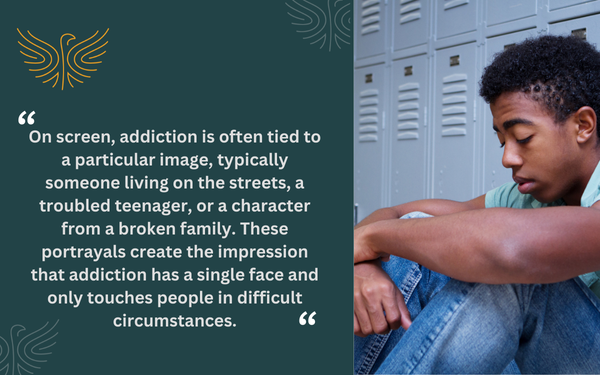Hollywood makes everything bigger, faster, and more dramatic than it is in real life. And while that might work for action scenes or love stories, when it comes to portraying addiction, these exaggerations can do real harm.
Movies and TV shows often reduce a complex, deeply personal struggle into stereotypes or neatly packaged storylines. And these portrayals often grab and keep our attention, yet they rarely capture the real experiences of individuals and families living with addiction.
At the end of the day, recovery isn’t about grand gestures or sudden transformations—it’s about ongoing care, support, and understanding. So, let’s separate fact from fiction. What are some common myths that movies and TV shows promote about addiction? And what is the reality?
_______________________________________________________
Myth #1: Addiction only affects certain types of people
On screen, addiction is often tied to a particular image, typically someone living on the streets, a troubled teenager, or a character from a broken family. These portrayals create the impression that addiction has a single face and only touches people in difficult circumstances.

But the reality is far broader. Addiction does not discriminate—it affects people of every age, background, and profession. Teachers, healthcare workers, parents, and successful business professionals can all struggle with substance use.
Myth #2: You have to hit rock bottom to start recovery.
Movies and TV shows love the dramatic moment when someone loses everything, has a near-death experience, or faces a crisis so big it finally forces them into recovery. While this inevitably makes for a powerful story arc, it creates a harmful misconception—that people can’t seek help until things are as bad as they can possibly get.
In reality, recovery can begin at any stage. Some people reach out for support when they notice substances interfering with work or relationships, long before a full-on crisis occurs. Others may choose treatment after encouragement from loved ones or a healthcare provider. In other words, waiting until “rock bottom” hits isn’t necessary and not the reality for many people.
Myth #3: Recovery happens quickly.
In many films, recovery is shown in a fast-paced sequence—a few days in treatment, a workout scene, some group therapy, and suddenly the character is back to normal or an entirely new person. This kind of storytelling may be engaging on screen, but it gives the false impression that recovery is short, simple, and straightforward.
Recovery is usually an ongoing process that looks different for everyone. It can take months or even years. And it often involves setbacks and small victories along the way. It also involves active participation from the person struggling with addiction. It requires effort, time, and even learning from mistakes. But it’s important to recognize that these aspects are all part of the journey and that recovery won’t occur overnight.
Myth #4: Willpower alone is enough to overcome addiction.
A powerful decision or emotional turning point is often all it takes for someone to quit—at least this is how it’s depicted on screen. Characters often grit their teeth, throw away the bottle, and move on as if sheer determination were the cure. But, like the other myths above, this is far from the truth.
Addiction is not simply a matter of choice or weak character—it’s a medical condition that affects the brain, body, and behavior. While personal commitment plays an important role in recovery, willpower alone rarely leads to lasting change. Treatment may include therapy, medication, lifestyle changes, and ongoing support from professionals and loved ones.
Framing recovery as just a matter of willpower can leave people feeling ashamed if they struggle or relapse. The truth is that asking for help and using available resources shows strength—not weakness.
Myth #5: Relapse means failure.
Television and movies often portray relapse as the tragic end of someone’s story, the moment when all hope is lost. This sends a damaging message that if someone slips back into substance use, they’ve failed and can’t recover.
But here’s the thing: relapse is common, and it doesn’t erase progress. For many, it is part of the recovery journey. A relapse can highlight stressors, triggers, or coping skills that still need attention, giving both individuals and their support systems valuable insight. The most important part here is how a person responds—seeking help again, adjusting their treatment plan, and continuing forward.
Myth #6: Love or family support alone can “fix” addiction
Many movies suggest that the love of a partner, the birth of a child, or a heartfelt family intervention is all it takes for someone to turn their life around. While support from loved ones can make a huge difference, it is not a cure for addiction.
Addiction is a complex condition that often requires professional treatment, often including counseling, medical care, support groups, or a combination of approaches. Family encouragement can provide hope, accountability, and connection, but lasting recovery usually involves structured care and ongoing effort from the individual.
Myth #7: Treatment looks the same for everyone
Rehab is often portrayed in a very specific way, such as a big house in the countryside, group therapy sessions, and a single path to recovery. And it gives the impression that rehab follows a similar script.
Yet, it’s important to recognize that treatment is highly individualized. For instance, some people benefit from inpatient programs, while others thrive in outpatient care that allows them to continue working or caring for family. Ultimately, each recovery plan is tailored to a person’s needs, history, and goals.
If you or a loved one is struggling with addiction, know that it’s never too late. At Freedom Recovery Centers (FRC), we can help you pave the way toward a happier and healthier life. Take that next step today and call us at 804-635-3746 or fill out our online form.
.svg)






.svg)

.svg)



.svg)
